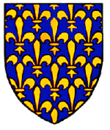

 Hugh Capet - First Capetian King of France
Hugh Capet - First Capetian King of France 


General Notes
Hugh Capet (French: Hugues Capet) (938 - October 24, 996) was King of France from 987 to 996. Capet is a nickname for "wearing a cape".
Born in 938 in Paris, he came from a powerful and influential family of the Germanic aristocracy of France, two members of which had already been elected King of France in the ninth and tenth centuries. Hugh Capet was the eldest son of Hugh the Great, then the most powerful man in the kingdom, maker of kings, and of Hedwige of Saxony (c.910-c.965), daughter of King Henry I (the Fowler) of Germany and sister of German Emperor Otto I. Hugh Capet wanted to become a lay abbot, and in 980 arranged to move the relics of St. Valery to Amiens Cathedral. He inherited his father's vast estates and became the most powerful noble of his time. From 978 to 986, Hugh Capet allied himself with the German emperors Otto II and Otto III and with archbishop Adalbero of Reims to dominate the weak Carolingian king, Lothair. By 985, he was king in all but name. After Lothair and his son died in early 987, the archbishop of Reims convinced an assembly of nobles to elect Hugh Capet as their king. He was crowned King of France at Noyon, Picardie on July 3, 987, the first of the Capetian dynasty to rule France.
Hugh Capet possessed minor properties near Chartres and Anjou. Between Paris and Orléans he possessed towns and estates amounting to approximately 400 square miles (1,000 km²). His authority ended there, and if he dared travel outside his small area, he risked being captured and held for ransom or even murdered. Indeed, there was a plot in 993 masterminded by the Bishop of Laon and Eudes I of Blois to deliver Hugh Capet into the custody of Otto III. The plot failed, but the fact that no one was punished illustrates how tenuous his hold on power was. Beyond his power base, in the rest of France, there were still as many codes of law as there were fiefdoms. The country operated with 150 different forms of currency and at least a dozen languages. Uniting all this into one cohesive unit was a formidable task and a constant struggle between those who wore the crown of France and its feudal lords. As such, Hugh Capet's reign was marked by numerous power struggles with the vassals on the borders of the Seine and the Loire. Beyond his realm, the investiture and then deposition of Arnulf, nephew of the duke of Lorraine, as archbishop of Reims involved the king and bishops in conflict with Pope John XV that was not yet resolved at Hugh Capet's death in 996.
While Hugh Capet's military power was limited and he had to seek military aid from the Duke of Normandy, his unanimous election as king gave him great moral authority and influence.
Hugh Capet married Adelaide of Aquitaine (952-1004), daughter of Duke William III of Aquitaine. Their children were:
Avoise (970-1013)
Robert II (March 27, 972 – July 20, 1031)
Alice (974-1079)
Gilette (born c.976)
Gisele (born c.978)
Hugh Capet died on October 24, 996 in Paris, and was interred in the Saint Denis Basilica. He was succeeded by his son, Robert II.
King of France
Preceded by:
Louis V
Succeeded by:
Robert II
Retrieved from "http://en.wikipedia.org/wiki/Hugh_Capet_of_France"
-
Ancestor Pedigree Chart
-
*There are earlier generations for the ancestor(s) indicated. See their page(s) for details (click name) - d.0956
- d.0956

- b.0938 d.0996


 - d.0936
- d.0936

 - b.0876 d.0936
- b.0876 d.0936




 <Unknown>
<Unknown>



 <Unknown>
<Unknown>




 <Unknown>*
<Unknown>*






 <Unknown>
<Unknown>
 - b.0910 d.0965
- b.0910 d.0965

 - b.0892 d.0968
- b.0892 d.0968
-
Page last modified
This page is within a frameset. View the entire genealogy report of Capet - First Capetian King of France families, or surname index of Capet - First Capetian King of France pedigrees or report summary Capet - First Capetian King of France heritage from 'Moore, Simpson, Ballard Family Tree - England and Scotland to Australia'.
Ancestry Family Tree.
Copyright © 2011 GenoPro Inc. All rights reserved.
